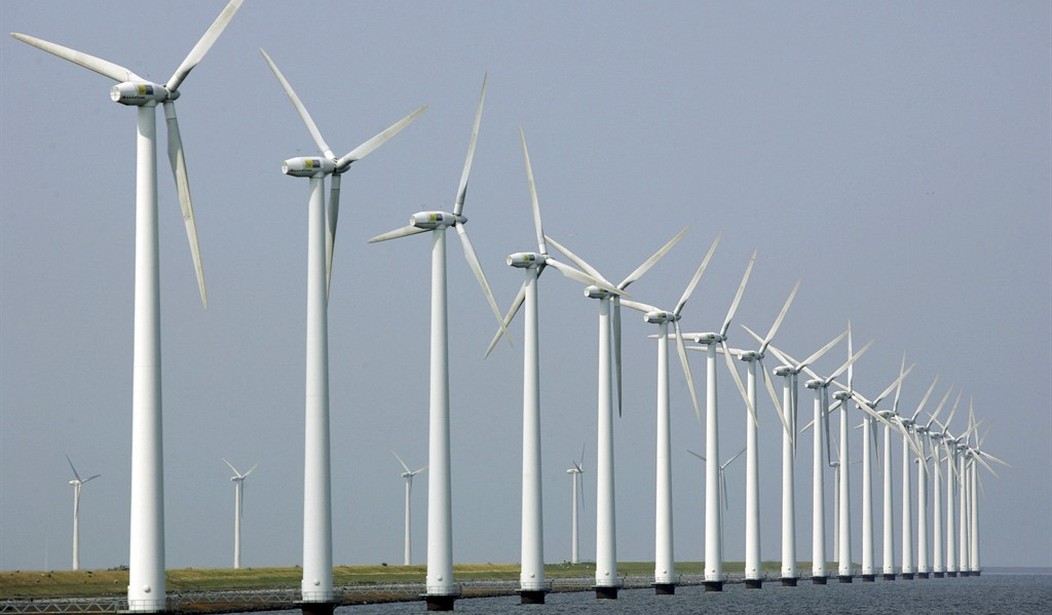Nothing more horrifying than a chirpy Energy Secretary tweet first thing in the morning. Especially when it contains the trifecta of bad news for taxpayers from one of the denser members of the Biden administration’s stable of lackluster cabinet mannequins:
1) Green energy
2) Unions
3) Federal incentives aka tax dollars
JOBS JOBS JOBS! "Hunerlach anticipates hundreds of union workers will be employed during construction, w/ additional permanent jobs once the facility is running. Statewide, he expects that the number of jobs created to […] be in the 'tens of thousands.'"https://t.co/BV5qQ4Dgni
— Secretary Jennifer Granholm (@SecGranholm) December 29, 2022
They finally held much-anticipated wind lease auctions on parts of the pristine California coast and the sharks are already circling in anticipation. It’s going to be a while yet, though.
…Jeff Hunerlach, a building trades union leader based in Humboldt County, doesn’t represent any maritime workers — but he expects a windfall of new jobs for his members from two clusters of wind turbines planned on floating platforms 20 miles off the coast.
While the turbines are unlikely to generate power for another decade, the transformation of 80 acres of waterfront land in Humboldt into a hub for offshore wind operators and their vessels is imminent following a federal lease auction earlier this month. Similar work will be needed in Morro Bay, onshore from three clusters of wind turbines.
…Substantial new waterfront infrastructure will be needed at Humboldt and Morro Bay to bring electricity from offshore wind turbines onto shore, where it will power homes, electric vehicles and industry.
…Efforts to build out the new industry will create jobs while providing federal incentives for developers to invest in coastal communities where new infrastructure will be needed.
Morro Bay is really quite a beautiful place. I’m wondering what that “substantial new waterfront infrastructure” all entails. Maybe the greenies won’t be so thrilled with it when the bulldozers come in?
In the meantime, plans are for a 3GW wind farm, built with pretty radical technology for the West Coast’s unique off-shore requirements. Basically the problem there is it drops off a cliff into the depths, not a gentle decline as on most of the East Coast. So they’re going to use floating platforms tethered to the seabed.
…Offshore wind farming off the West Coast is complicated by the closeness to shore of the steep continental shelf. Waters viable for wind farming are too deep for the towers that hold most offshore turbines in place worldwide. The wind farms off California will be among the first in the world to float on giant platforms tethered to the seafloor and connected to land through electrical cables.
…”Floating platforms are going through a period of great innovation,” said Stephanie McClellan, executive director of the nonprofit Turn Forward, which aims to accelerate the build-out of offshore wind farms nationally. Gas-and-oil drillers already use floating turbines, and some of those designs are being adapted for wind farming.
“We’re starting to see a variety of different innovations, a number of different designs,” McClellan said. “We’ll start to see which of these are going to rise to the top in terms of usage.”
While floating technology is essential for building wind turbines along California’s coast, it in many ways could turn out to be superior to the fixed-tower turbines that currently dominate the industry.
That’s because building further offshore, where floating technology would be required even along the East Coast and along other shallower coastlines, reaches stronger winds while reducing potential conflicts with fishing fleets. It can also ease concerns of residents and tourism operators about impacts of wind farms on ocean views. “There’s higher wind speeds in deeper waters,” McLellan said.
YOWSAHS
The whole concept is pretty wild sounding because I know how monstrous the Pacific is and how humongous the waves can be when she is cranky – ask any U.S. sailor or sea duty Marine in the PacFleet. Epic stuff. And according to a wind energy industry new letter, it’s not really even a “thing” yet – they call it “maturing.”
…Several moves in 2022 point to a new frontier for offshore wind in the United States: floating turbines for deeper waters.
It’s a maturing area to moor turbines to the sea floor without using steel jackets or monopiles, still in its infancy even in Europe, where offshore wind has developed faster than in the U.S. It will be necessary to tap much of the global offshore wind potential, such as in the Pacific Ocean, the Gulf of Maine and in new areas of the Atlantic.
“You can count the number of turbines on the floating side on two hands,” said Milito. “So that’s not an extremely mature technology, but it’s a technology that is in place and it’s ready to go. It’s been proven, it’s feasible and it’s something that will be commercial rather quickly.”
In a nod to both the need and demand for floating technology, the Biden administration committed to lifting 15 GW of floating offshore wind by 2035, a target meant to speed maturation.
The announcement came with a research and development initiative housed at the Department of Energy aimed at slashing the cost of floating offshore wind development by 70 percent by 2035. DOE aims to reach $45 per megawatt-hour for floating offshore wind power.
BOEM underscored the U.S. interest in floating wind, again, when it released draft wind energy areas in the mid-Atlantic, located much farther from shore than the first leases sold and in some of the deepest waters yet for federal leasing.
“We were quite surprised to see the depths of the areas up to 2,000 meters. It’s really taking the next step in terms of deepwater applications and challenges,” Nørgaard said.
So the Biden administration put out lease maps before checking with the industry that they had the technology to utilize the lease area? Is that what I’m reading here? Talk about your confidence builder. 2K meters is about a mile and a quarter for the metric challenged like me. That’s one heckuva tether, before the storm allowances. That was for the Atlantic.
During the public comment period for the Morro Bay lease, the Federal Bureau of Ocean Energy Management had two proposed lease sites comprising a 396-mile square patch.
…concerning the plans to install hundreds of floating wind turbines in a 396-square mile (240,898 acres) patch of ocean, providing some 3 gigawatts (GW) of energy.
BOEM is working towards an auction of leases for the so-called “Morro Bay Wind Energy Area,” sited 17-20 miles offshore from San Simeon. A similar lease sale held on the East Coast recently brought in over $1 billion.
…The EA’s definition of the project gives two size options — Option 1 covers 255,000 acres and Option 2 is 240,000 acres. The two options vary in depth of water too, with Option 1 going from 800-1300 meters deep and Option 2 is 900-1300 meters.
That’s a lot of windmills in deep water.
There’s another wrinkle. No one touched base with the fisher folk or the Native American tribes who work those waters and revere those pristine shores.
…”We’re going to throw billions of dollars into something that we don’t really know what the impact is going to be,” said Dick Ogg, a commercial fisherman of crab, albacore, black cod and rockfish. He’s based out of Bodega Bay but chases salmon from the state’s North Coast south to Morro Bay, which is another quiet part of California where an infrastructure boom is planned to get electricity from offshore wind turbines to land-based power customers. “We’d like to see a project that is smaller.”
Fishing fleets nationally are angry about what they say is a lack of consultation with them by wind developers and by the federal government, with hundreds of lobstermen in Maine attending protests about plans there. Tribes, too, say their members are being ignored.
“We’re asking developers to simply view us for what we are: sovereign nations,” said Frankie Myers, vice chairman of the Yurok Tribe, who for thousands of years have lived on the redwood coast and along the Klamath River in what is now northwestern California.
Yurok tribal leaders spoke with half a dozen potential developers in advance of California’s offshore wind auction, but Myers said they weren’t consulted by RWE or the other auction winners.
…”The last thing we want to do is destroy the environment in the process of trying to save it.” Myers said. “This gung ho approach of having a single-minded goal is exactly how that happens. We have to look at this. We have to weigh every step. That’s what we do as tribal people.”
RWE’s Eaton said the company had held off on engaging with groups like fishing fleets and tribes in California until it had won a lease at auction. “We’re prepared to begin those dialogues very soon,” he said.
I don’t hold out much hope for the fishing industry having any influence or impact whatsoever on the future of this project, but the tribes could be a horse of a different color and might be able to throw a wrench in it if they don’t get the right answers. Talk about lip service. Pretty amazing how Democrats are all about minorities until they interfere with their pet projects. Then they might get a sympathy card after being run over if they get any acknowledgment at all.
This is all part and parcel of allowing our future to be hijacked while destroying our standard of living by people who are mainstreaming beliefs like these:
…“The biggest barrier is a lack of imagination,” Griffith [ Saul Griffith, an entrepreneur who’s sold companies to Google and Autodesk and has written books on mass electrification] told CNBC in a video interview from Australia, where he currently lives. “So everyone is like, ‘Well, I’m not quite willing to do this, because I don’t know what it’s going to look like. And maybe it’s going to be terrible.’”
So what would a 100% renewable-powered world look like, according to Griffith?
“It’s going to look like every house has solar on its roof. There’ll be solar over every parking structure. Some roads will probably have a solar panels elevated down the middle of the road. And every time you go driving in the countryside, you’ll see some wind somewhere on the horizon,” Griffith said.
“And otherwise, the future is going to look a lot like it does.”
…“In Norway, you can’t buy a gasoline vehicle after 2025. That creates a huge amount of market certainty. Everyone knows when it’s going to happen, what you have to do,” Griffith said.
The Inflation Reduction Act in August 2022 was chock full of incentives to push renewables forward, but it didn’t put any firm sunsetting dates on fossil fuel generation.
“It doesn’t really clearly send a signal to the utilities that, ‘No, you can’t install natural gas networks to heat homes anymore. No, you can’t do this or that or the other.’ So I think more regulatory, legislative certainty would help America a lot,” said Griffith.
Until then, its going to continue to be cheaper and easier to keep doing things the same old way.
What you HAVE to do.
See, the thing is, Saul, buddy – we don’t have to do any of it.








Join the conversation as a VIP Member